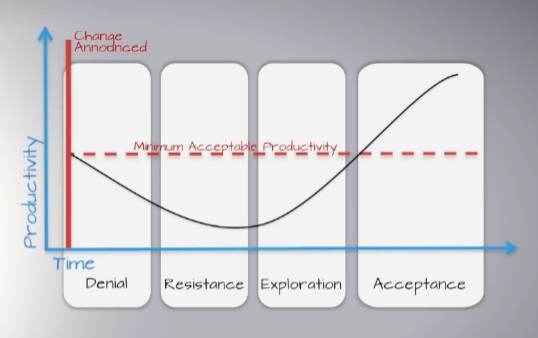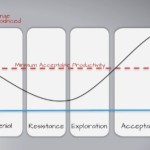Let’s make a very important distinction between change and transition. Change refers to external events. For example, change is renting a new apartment in a different neighborhood and moving all your belongings . In contrast, transition refers to the internal psychological and emotional reactions that you have to the external changes. For example, transition is missing your old neighborhood, feeling confused about where to shop, and worrying that you won’t fit in with your new neighbours.
Similarly, change might be a reorganisation, a new manager, updated software, new products, or any of the other events that alter your work. While you sometimes create the changes that affect you, especially in your personal life, changes at work often are imposed on you by others – you are not in control. In contrast, the way you react during transition is always a choice – your responses during transition are within your control.
 I once saw a bumper sticker that said, “Change is inevitable. Struggle is an option.” In other words, the world around you is constantly changing, and there’s not much you can do about it. But how you react to those changes is your choice.
I once saw a bumper sticker that said, “Change is inevitable. Struggle is an option.” In other words, the world around you is constantly changing, and there’s not much you can do about it. But how you react to those changes is your choice.
Each person experiences transition in their own way. However, there are some very clear patterns in the way that most people react to external changes, especially changes that are imposed on them by others or by circumstances beyond their control.
- Denial
When a change occurs, the first reaction is typically denial. Have you ever walked out to your car only to discover that you have a flat tire? Have you ever heard yourself say, “Flat tire! No way! I can’t have a flat tire. I have a meeting that I have to go to. No!” The flat tire is staring you in the face, but your first reaction is often to deny the reality of what you don’t want to happen. - Resistance
The next phase of transition involves any of a number of emotional reactions referred to collectively as resistance. “I just bought these tires. They cost a fortune, and they told me that it’s nearly impossible to get a flat. I was cheated!” Anger is a fairly common response to change, along with fear, anxiety, frustration, or a sense of loss. - Exploration
The third phase is exploration. “Well, I have to get to that meeting. What am I going to do? I could change the tire myself, but I’m not sure I can loosen the lug nuts on the wheel. Maybe someone in the parking lot could help me. Oh, wait a minute. Did I renew my roadside rescue membership? I could call for help.” During exploration you start looking at the options for moving forward with change, even if you’re not thrilled about it. - Acceptance
“I’ll just call roadside rescue and have them change the tire.” Acceptance is the final phase of transition. You move ahead with change, incorporating it into your revised set of activities.
This transition process is normal and natural – it’s the way people are designed, so there’s nothing wrong with transition. The problem occurs when you get stuck in transition and don’t move forward toward acceptance of the new situation.
So, what’s the link between transition and resilience? We defined resilience as the ability to respond effectively to change not just once, but as a natural response to relentless change. Now, given our understanding of transition, we have another way of defining resilience. Resilience involves moving through transition quickly and effectively, without skipping steps and without getting stuck. Author and consultant William Bridges summed it up very well.
It’s not the changes that do you in, it’s the transitions.

